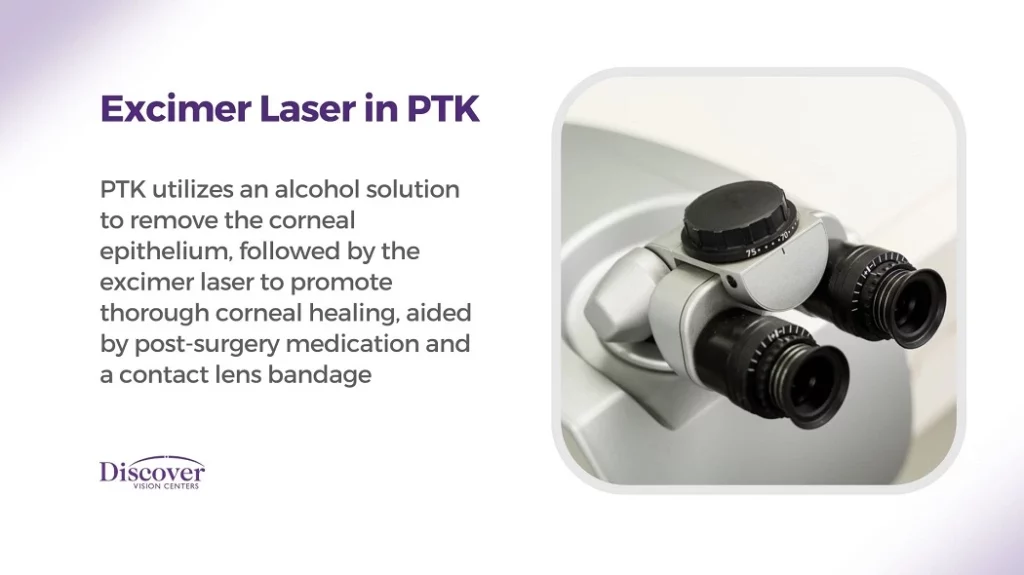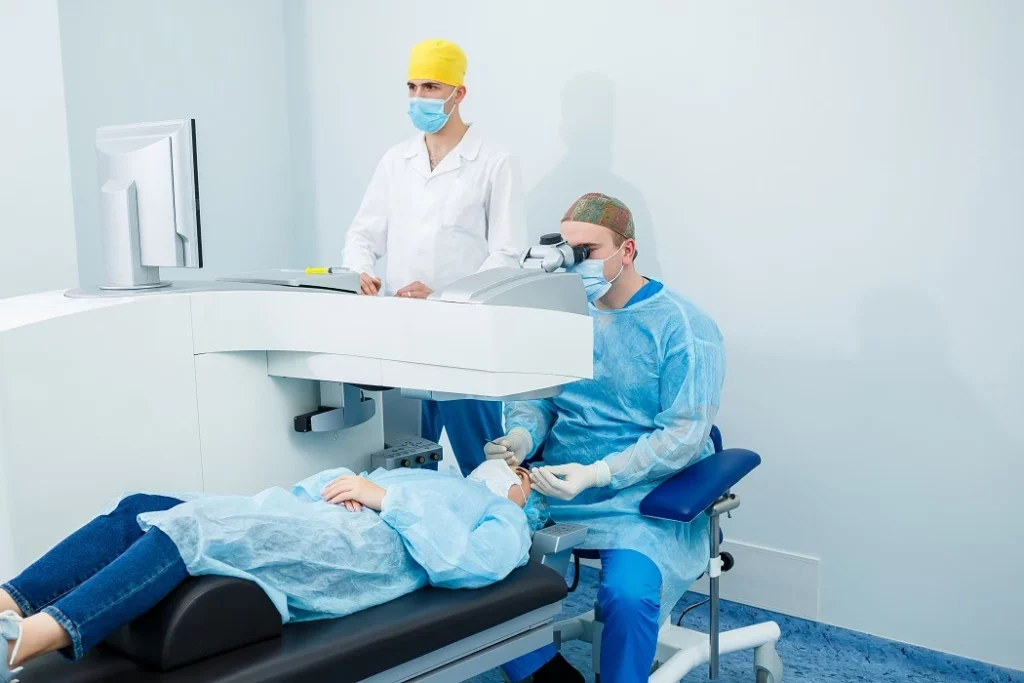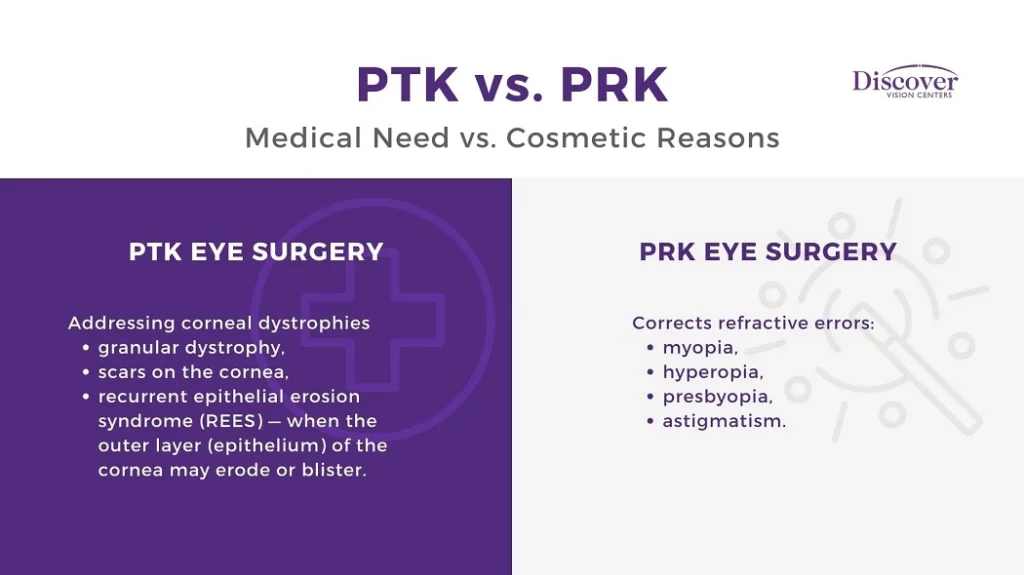
Updated: February 09, 2024
PTK (Phototherapeutic Keratectomy) and PRK (Photorefractive Keratectomy) are both procedures that utilize the excimer laser applied to the cornea or front surface of the eye. There are, however, differences in the indications and eye conditions when determining when to use PTK vs PRK laser surgery. PTK is the chosen procedure when managing or removing cloudiness or surface irregularity on the cornea that may be a result of scars or dystrophies. PRK is a refractive surgery procedure that reshapes the surface of the eye with the idea of reducing or eliminating the need for contacts and glasses.

PTK, or Phototherapeutic Keratectomy, is a specialized eye surgery that focuses on treating various conditions affecting the cornea’s surface. Unlike other laser eye procedures primarily aimed at vision correction, PTK surgery is designed to address issues such as corneal scars, dystrophies, or other irregularities that hinder the eye’s ability to see clearly. During PTK, the surgeon uses an excimer laser to gently remove the damaged or irregular corneal tissue, promoting the growth of healthy cells and improving the overall health and function of the eye. This phototherapeutic keratectomy procedure offers relief to individuals suffering from corneal conditions, enhancing their visual comfort and quality of life.
PTK surgery (Phototherapeutic Keratectomy) is an effective solution for addressing a range of eye diseases and conditions that primarily affect the corneal surface. Conditions Treated with PTK include:

The specific details of the procedure may vary depending on the patient’s condition and the surgeon’s preferences. It is essential to discuss the procedure and its specifics with your healthcare provider before undergoing PTK.
Recovery from PTK (Phototherapeutic Keratectomy) typically involves a few days to weeks of healing. During this time, you may experience light sensitivity, tearing, and discomfort. It’s essential to use prescribed eye drops and protect your eyes from bright light. Vision gradually improves as the cornea heals. Follow your ophthalmologist’s instructions for a successful recovery.
PTK (Phototherapeutic Keratectomy) is a surgical treatment for corneal issues. Its success rate varies based on the specific condition, surgeon’s skill, and patient’s response. Typically, it’s effective in improving vision and reducing symptoms, with better outcomes for milder conditions and suitable candidates. Individual evaluation by an ophthalmologist is crucial. PTK, while generally safe, carries potential risks, so patients should discuss the procedure’s pros and cons with their healthcare provider.
PTK surgery, or Phototherapeutic Keratectomy, is generally safe and effective, but like any medical procedure, it comes with some potential risks and complications. These can include infection, corneal scarring, temporary or persistent vision changes, and discomfort during the healing process. However, it’s important to note that these risks are relatively uncommon, and the benefits of a PTK procedure often outweigh the potential drawbacks, providing relief to individuals with corneal surface issues. Discussing these risks with your eye care provider is essential for informed decision-making.

Excimer laser PRK (Photorefractive Keratectomy) is a type of laser eye surgery designed to correct common vision problems. During PRK, the outer layer of the front surface of the eye called the corneal surface or epithelium, is gently removed before reshaping the cornea with a laser to improve visual acuity. It is an effective alternative to traditional eyeglasses or contact lenses for many individuals.
PRK is an excimer laser eye surgery primarily used to treat common refractive errors, including:
PRK is a vision correction reshaping of the cornea. PRK typically involves a longer recovery period compared to LASIK. The epithelial layer, removed during the surgery, regenerates over a few days to a week. During this time, patients may experience some discomfort and blurry vision. Full visual recovery can take a few weeks to several months, but many patients achieve improved vision within a few weeks of the surgery.

Recovering from PTK (Phototherapeutic Keratectomy) involves several important aspects. This process encompasses the healing of the corneal surface following the removal of damaged tissue and the integration of new epithelial cells to restore eye health.
PTK (Phototherapeutic Keratectomy) surgery has a high success rate for treating corneal surface irregularities, with many patients experiencing significant improvement in vision and relief from discomfort. However, the specific success rate can vary depending on the underlying condition and individual factors.
While PRK (Photorefractive Keratectomy) is generally considered safe and effective, there are certain risks to be aware of. These include infection, dry eye, corneal haze, and suboptimal visual outcomes. However, these risks are relatively rare, and many patients achieve improved vision and quality of life through PRK. It’s essential to discuss these risks with a qualified eye surgeon before undergoing the procedure.

PRK (Photorefractive Keratectomy) and PTK (Phototherapeutic Keratectomy) are laser eye surgeries, but they serve different purposes. PRK is a vision correction procedure, reshaping the cornea to improve eyesight by reducing if not eliminating refractive error. PTK, on the other hand, is primarily used for treating corneal surface irregularities, such as scars and dystrophies. While both surgeries involve corneal reshaping, it’s crucial to understand their distinct goals and applications. This knowledge can help individuals make informed decisions about which procedure is suitable for their specific eye condition and needs.
Discover Vision is your top choice for refractive surgery in the Kansas City area. With state-of-the-art facilities and a team of experienced ophthalmologists, they offer a wide range of laser vision correction procedures, including LASIK, PRK, and lens implants. Patients benefit from cutting-edge technology and personalized care to achieve optimal visual outcomes. Located in the heart of Kansas City, Discover Vision provides convenient access to world-class eye care, making it the preferred destination for those seeking safe and effective refractive surgery.